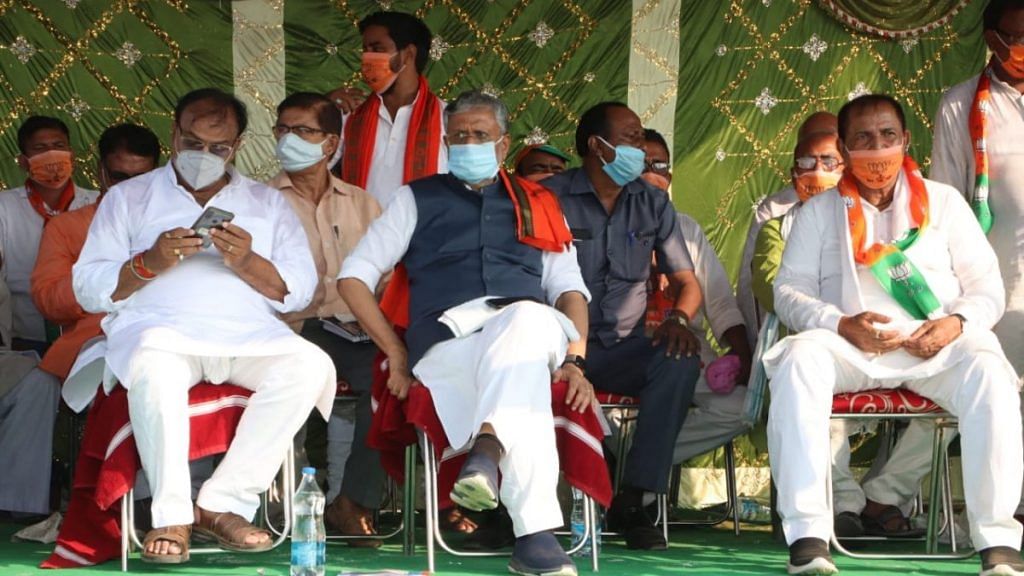New Delhi: The BJP has a dedicated upper caste vote-bank in Bihar and the party’s ticket allocation reflects that. Of the BJP’s 110 candidates, 51 are upper caste, even though they constitute only 16 per cent of Bihar’s population.
Of these 51 upper castes, 22 tickets have gone to Rajputs, 15 to Bhumihars, 11 to Brahmins and three to Kayasthas.
The remaining 59 seats have gone to Other Backward Classes (OBCs), Scheduled Castes and Scheduled Tribes who comprise 74 per cent of the state’s population. Of these, 15 tickets have gone to Yadavs, the dominant OBC caste in Bihar that the opposition Rashtriya Janata Dal (RJD) draws its strength from.
The BJP is sticking to its traditional strategy of relying on upper castes in elections. In the 2015 assembly polls, for instance, the BJP had fielded 65 upper caste candidates, the highest by any party. Back then, it had contested in 157 of the 243 seats and secured victories in 53 of them.
“We have included every caste in our list but the BJP has to allocate seats according to the castes that support it,” a senior BJP leader told ThePrint.
“Over the past 30 years, upper castes have fought the jungle raj of Lalu Prasad Yadav. So naturally they have been given better representation but OBCs and SCs have also been given equal representation.”
Sanjay Kumar of the Centre for the Study of Developing Societies (CSDS) says the BJP is sticking with upper castes as there has been no religious polarisation of voters this time around.
“Upper castes have traditionally been the backbone of the BJP,” Kumar said. “Religious polarisation usually diffuses caste arithmetic but this time there has been no polarisation. So the BJP is sticking to its core vote-bank of upper castes and OBCs.”
In contrast, just 19 upper castes figure in the list of 115 candidates released by the BJP’s ally, the JD(U). Of these, 10 are Bhumihar, seven are Rajputs and two seats have gone to Brahmins. The JD(U) has, however, handed 18 tickets to Yadav candidates.
Also read: ‘Bihar Mein Ee Ba’ is BJP’s reply in rap to Manoj Bajpayee song on migrant crisis
Focus on Rajputs
While Bhumihars have been the most loyal of BJP voters, the party has also been looking to consolidate Rajputs in the state since the 2014 Lok Sabha polls.
In the 2015 assembly elections, the BJP had fielded 30 Rajputs, 18 Bhumihars, 14 Brahmins and three baniyas.
The BJP had also looked to gain politically from the death of actor Sushant Singh Rajput, who committed suicide in June. It appointed former Maharashtra chief minister Devendra Fadnavis as the Bihar campaign incharge to rake up the death of the actor who hailed from the state.
The party has also renominated Neeraj Kumar Singh Bablu, the sitting MLA from Chhatapur constituency in Supaul district, who is also the actor’s cousin.
The party’s star campaigner list also includes prominent Rajput leaders such as Radhamohan Singh, Sushil Singh and Union Minister R.K. Singh.
“Rajputs largely vote for the BJP except when prominent leaders from their caste contest on other tickets,” said one vice-president of the Bihar BJP unit.
“Rajputs have backed Prabhunath Singh when he switched over from the JD(U) to the RJD. They also backed Raghuvansh Prasad Singh and Jagdanand Singh who were both with the RJD. But the BJP efforts to get the Rajput vote undivided is bearing fruit.”
Yadavs get representation
The BJP has also maintained its record of giving Yadavs fairly decent representation. While it had handed 22 tickets to Yadavs in the 2015 polls, this time around it has awarded 15 tickets.
This despite the fact that in the last elections, only six of the 22 Yadav candidates managed to win.
The Yadavs mostly back the RJD and had dominated the 2015 assembly polls. Of the 243 legislators in the outgoing assembly, 61 are Yadavs — every fourth MLA.
The majority of them, 42, were from the RJD, followed by the 11 from the JD(U) and six of the BJP.
Since 2014, however, the BJP has been attempting to woo the younger Yadav voters. Then party president Amit Shah had appointed Nityanand Rai as the Bihar BJP president in 2014. He has now been inducted into the Union cabinet.
The party has also anointed Ramkripal Yadav, once a close confidante of Lalu Prasad Yadav, Nand Kishore Yadav, Hukum Dev Narayan Yadav and Bhupendra Yadav as star campaigners.
“Yadav disillusionment with RJD is happening across Bihar. The older Yadavs are still with RJD but the younger generation wants nothing to do with caste politics. They are aspirational and are inspired by PM Modi,” said Ramkripal Yadav, who is now a BJP MP.
“After Lalu, Tejashwi will not be able to hold onto this Yadav vote-bank. They will switch over to the BJP.”
D.M. Diwakar of the Patna-based A.N. Sinha Institute of Social Studies said, “The BJP-JD(U) works on simple arithmetic. While the BJP largely transfers upper caste votes to the JD(U), Nitish brings EBC and OBC votes. So the BJP hands more tickets to upper castes and the JD(U) to EBCs and OBCs.”
Also read: BJP’s ‘damage control’ after Bihar opinion poll — 9 rebels contesting on LJP ticket suspended
